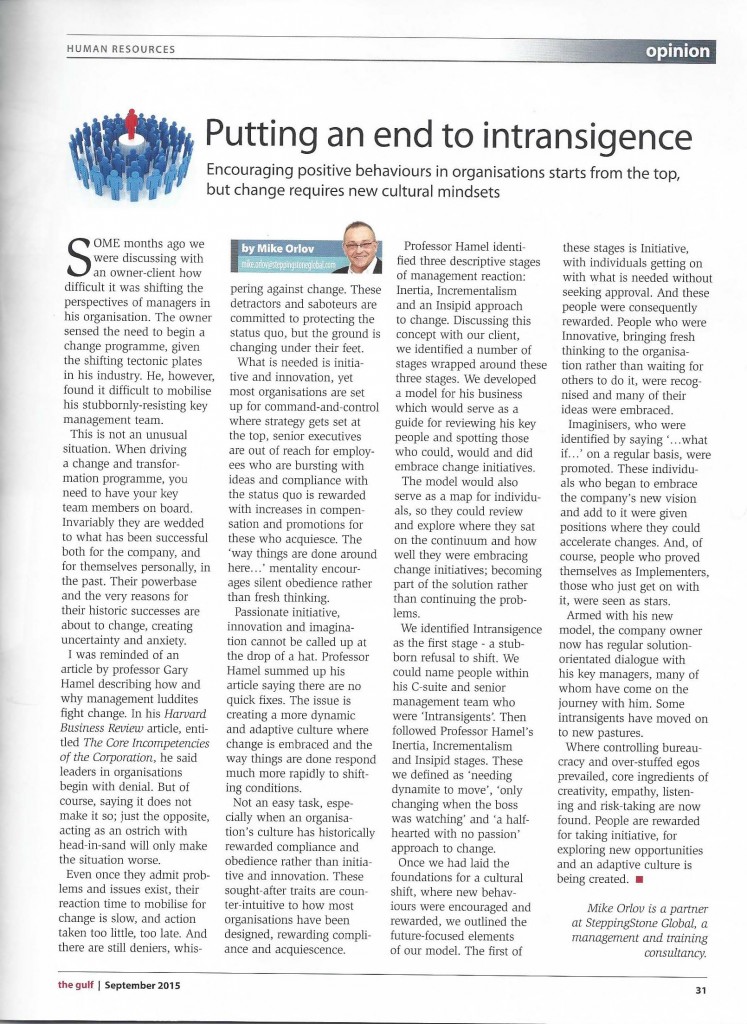Some months ago we were discussing with an owner-client how difficult it was shifting the perspectives of managers in his organization. The owner sensed the need to begin a change program, given the shifting tectonic plates in his industry. He however found it difficult to mobilize his stubbornly-resisting key management team.
This is not an unusual situation. When driving a change and transformation program, you need to have your key team members on board. Invariably they are wedded to what has been successful both for the company, and for themselves personally, in the past. Their powerbase and the very reasons for their historic successes are about to change, creating uncertainty and anxiety.
I was reminded of an article written by Professor Gary Hamel describing how and why management luddites fight against change, notwithstanding change being the only certainty facing them. In his Harvard Business Review article, entitled The Core Incompetencies of the Corporation, Professor Hamel said leaders in organizations begin with denial. But of course, saying it does not make it so; just the opposite, acting as an ostrich with head-in-sand will only make the situation worse.
Even once they admit problems and issues exist, their reaction time to mobilizing for change is slow. Often belated, the action taken by leaders is too little, too late. And there are still deniers, whispering against change. These detractors and saboteurs are committed to protecting the status quo, but the ground is changing under their feet.
What is needed is initiative and innovation, yet most organizations are set-up for command-and-control where strategy gets set at the top, senior executives are out of reach for employees who are bursting with ideas and compliance with the status quo is rewarded with increases in compensation and promotions for these who acquiesce. The ‘..way things are done around here…’ mentality encourages silent obedience rather than fresh thinking.
Passionate initiative, innovation and imagination cannot be called-up at the drop of a hat. Professor Hamel summed up his article saying there are no quick fixes. The issue is creating a more dynamic and adaptive culture where change is embraced and the way things are done within the organization respond much more rapidly to shifting conditions.
Not an easy task, especially when an organization’s culture has historically rewarded compliance and obedience rather than initiative and innovation. These sought-after traits are counter-intuitive to how most organizations have been designed, rewarding compliance and acquiescence.
Professor Hamel identified three descriptive stages of management reaction: Inertia, Incrementalism and then an Insipid approach to change.
Discussing this concept with our client, we identified a number of stages wrapped around these three descriptive stages. We developed a model for his business which would serve as a guide for reviewing his key people and spotting those who could, would and did embrace change initiatives.
The model would also serve as a map for individuals themselves, so they could review and explore where they sat on the continuum and how well they were embracing change initiatives; becoming part of the solution rather than continuing the problems.
We identified Intransigence as the first stage – a stubborn refusal to shift. We could name people within his C Suite and senior management team who were ‘Intransigents’. Then followed Professor Hamel’s Inertia, Incrementalism and Insipid stages. These we defined as ‘needing dynamite to move’, ‘only changing when the boss was watching’ and ‘a half-hearted with no passion’ approach to change.
Once we had laid the foundations for a cultural shift, where new behaviors were encouraged and rewarded, we outlined the future-focused elements of our model. The first of these stages is Initiative, with individuals getting on with what is needed to be done without seeking approval. And these people were consequently rewarded. People who were Innovative, bringing fresh thinking to the organization rather than waiting for others to do it, were recognized and many of their ideas were embraced.
Imaginizers, who were identified by saying ‘…what if…’ on a regular basis, were promoted. These individuals who began to embrace the company’s new vision and add to it were given positions where they could accelerate changes. And of course, people who proved themselves as Implementers, those who just get on with it, were seen as stars.
Armed with his new model, the owner of the company is now having regular solution-orientated dialogue with his key managers, many of whom have come on the journey with him. Some intransigents have moved on to new pastures. The organization has seen the cultivation of a culture where positive actions and behaviors are focused on, with change being embraced and rewarded.
Where controlling bureaucracy and over-stuffed egos prevailed, core ingredients of creativity, empathy, listening and risk-taking are now found. People are rewarded for taking initiative, for exploring new opportunities and an adaptive culture is being created.

